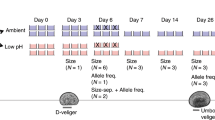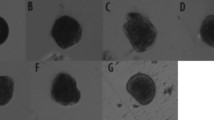Abstract
Populations of marine fish, even from contrasting habitats, generally show low genetic differentiation at neutral genetic markers. Nevertheless, there is increasing evidence for differences in gene expression among populations that may be ascribed to adaptive divergence. Studying variation in salinity tolerance and gene expression among Atlantic cod (Gadus morhua) from two populations distributed across a steep salinity gradient, we observed high mortality (45% North Sea cod and 80% Baltic Sea cod) in a reciprocal common garden setup. Quantitative RT-PCR assays for expression of hsp70 and Na/K-ATPase α genes demonstrated significant differences in gene regulation within and between populations and treatment groups despite low sample sizes. Most interesting are the significant differences observed in expression of the Na/K-ATPase α gene in gill tissue between North Sea and Baltic cod. The findings strongly suggest that Atlantic cod are adapted to local saline conditions, despite relatively low levels of neutral genetic divergence between populations.





Similar content being viewed by others
References
Babu MM, Aravind L (2006) Adaptive evolution by optimizing expression levels in different environments. Trends Microbiol 14:11–14
Basu N, Nakano T, Grau EG, Iwama GK (2001) The effects of cortisol on heat shock protein 70 levels in two fish species. Gen Comp Endocrinol 124:97–105
Cossins AR, Crawford DL (2005) Opinion: fish as models for environmental genomics. Nature Rev Genet 6:324–333
Deane EE, Woo NYS (2004) Differential gene expression associated with euryhalinity in sea bream (Sparus sarba). Am J Physiol Regul Integr Comp Physiol 287:R1054–R1063
Deane EE, Kelly SP, Luk JCY, Woo NYS (2002) Chronic salinity adaptation modulates hepatic heat shock protein and insulin-like growth factor I expression in black sea bream. Mar Biotechnol 4:193–205
DeLong EF, Karl DM (2005) Genomic perspectives in microbial oceanography. Nature 437:336–342
Doebeli M, Dieckmann U (2003) Speciation along environmental gradients. Nature 421:259–264
Evans DH, Piermarini PM, Choe KP (2005) The multifunctional fish gill: dominant site of gas exchange, osmoregulation, acid-base regulation, and excretion of nitrogenous waste. Physiol Rev 85:97–177
Fangue NA, Hofmeister M, Schulte PM (2006) Intraspecific variation in thermal tolerance and heat shock protein gene expression in common killifish, Fundulus heteroclitus. J Exp Biol 209:2859–2872
Garcia de Leaniz C, Fleming IA, Einum S, Verspoor E, Jordan WC, Consuegra S, Aubin-Horth N, Lajus D, Letcher BH, Youngson AF, Webb JH, Vøllestad LA, Villanueva B, Ferguson A, Quinn TP (2007) A critical review of adaptive genetic variation in Atlantic salmon: implications for conservation. Biol Rev 82:173–211
Gilad Y, Oshlack A, Rifkin SA (2006) Natural selection on gene expression. Trends Genet 22:456–461
Goetz FW, MacKenzie S (2008) Functional genomics with microarrays in fish biology and fisheries. Fish Fish 9:378–395
Hammer Ø, Harper DAT, Ryan PD (2001) PAST: paleontological statistics software package for education and data analysis. Palaeontologia Electronica 4:1–4
Johannesson K, Andre C (2006) Life on the margin: genetic isolation and diversity loss in a peripheral marine ecosystem, the Baltic Sea. Mol Ecol 15:2013–2029
Larsen PF, Nielsen EE, Williams TD, Hemmer-Hansen J, Chipman JK, Kruhøffer M, Grønkjaer P, George SG, Dyrskjøt L, Loeschcke V (2007) Adaptive differences in gene expression in European flounder (Platichthys flesus). Mol Ecol 16:4674–4683
Larsen PF, Nielsen EE, Koed A, Thomsen DS, Olsvik PA, Loeschcke V (2008a) Interpopulation differences in expression of candidate genes for salinity tolerance in winter migrating anadromous brown trout (Salmo trutta L.). BMC Genetics 9:12
Larsen PF, Nielsen EE, Williams TD, Loeschcke V (2008b) Intraspecific variation in expression of candidate genes for osmoregulation, heme biosynthesis and stress resistance suggests local adaptation in European flounder (Platichthys flesus). Heredity 101:247–259
Larsen PF, Schulte PM, Nielsen EE (2011) Gene expression analysis for identification of selection and local adaptation in fishes. J Fish Biol 78:1–22
Lee CE, Petersen CH (2002) Genotype-by-environment interaction for salinity tolerance in the freshwater-invading copepod Eurytemora affinis. Physiol Biochem Zool 75:335–344
Lejeusne C, Perez T, Sarrazin V, Chevaldonne P (2006) Baseline expression of heat-shock proteins (HSPs) of a “thermotolerant” Mediterranean marine species largely influenced by natural temperature fluctuations. Can J Fish Aquat Sci 63:2028–2037
Livak KJ, Schmittgen TD (2001) Analysis of relative gene expression data using real-time quantitative PCR and the 2(T)(-Delta Delta C) method. Methods 25:402–408
Marcil J, Swain DP, Hutchings JA (2006) Countergradient variation in body shape between two populations of Atlantic cod (Gadus morhua). Proc Royal Soc B Biol Sci 273:217–223
McCormick SD (2001) Endocrine control of osmoregulation in teleost fish. Am Zoologist 41:781–794
McKay JK, Bishop JG, Lin JZ, Richards JH, Sala A, Mitchell-Olds T (2001) Local adaptation across a climatic gradient despite small effective population size in the rare sapphire rockcress. Proc Royal Soc B Biol Sci 268:1715–1721
Nielsen EE, Hansen MM, Bach L (2001a) Looking for a needle in a haystack: discovery of indigenous salmon in heavily stocked populations. Conserv Genet 2:219–232
Nielsen EE, Hansen MM, Schmidt C, Meldrup D, Gronkjaer P (2001b) Fisheries: population of origin of Atlantic cod. Nature 413:272–272
Nielsen EE, Hansen MM, Ruzzante DE, Meldrup D, Gronkjaer P (2003) Evidence of a hybrid-zone in Atlantic cod (Gadus morhua) in the Baltic and the Danish Belt Sea revealed by individual admixture analysis. Mol Ecol 12:1497–1508
Nielsen EE, Gronkjaer P, Meldrup D, Paulsen H (2005) Retention of juveniles within a hybrid zone between North Sea and Baltic Sea Atlantic cod (Gadus morhua). Can J Fish Aquat Sci 62:2219–2225
Nissling A, Westin L (1997) Salinity requirements for successful spawning of Baltic and Belt Sea cod and the potential for cod stock interactions in the Baltic Sea. Marine Ecol Progress Series 152:261–271
Oleksiak MF, Churchill GA, Crawford DL (2002) Variation in gene expression within and among natural populations. Nat Genet 32:261–266
Ottera H, Agnalt AL, Jorstad KE (2006) Differences in spawning time of captive Atlantic cod from four regions of Norway, kept under identical conditions. Ices J Marine Sci 63:216–223
Poulsen NA, Nielsen EE, Schierup MH, Loeschcke V, Gronkjaer P (2006) Long-term stability and effective population size in North Sea and Baltic Sea cod (Gadus morhua). Mol Ecol 15:321–331
Rozen SS, Skaletsky HJ (2000) Primer3 on the WWW for general users and for biologist programmers. 365–386
Sangiao-Alvarellos S, Laiz-Carrion R, Guzman JM, Martin del Rio MP, Miguez JM, Mancera JM, Soengas JL (2003) Acclimation of S-aurata to various salinities alters energy metabolism of osmoregulatory and nonosmoregulatory organs. Am J Physiol Regul Integr Comp Physiol 285:R897–R907
Sangiao-Alvarellos S, Arjona FJ, Martin del Rio MP, Miguez JM, Mancera JM, Soengas JL (2005) Time course of osmoregulatory and metabolic changes during osmotic acclimation in Sparus auratus. J Exp Biol 208:4291–4304
Schulte PM (2001) Environmental adaptations as windows on molecular evolution. Comp Biochem Physiol B Biochem Mol Biol 128:597–611
Schulte PM (2007) Responses to environmental stressors in an estuarine fish: Interacting stressors and the impacts of local adaptation. J Thermal Biol 32:152–161
Scott GR, Schulte PM (2005) Intraspecific variation in gene expression after seawater transfer in gills of the euryhaline killifish Fundulus heteroclitus. Comp Biochem Physiol A Mol Integr Physiol 141:176–182
Scott GR, Rogers JT, Richards JG, Wood CA, Schulte PM (2004) Intraspecific divergence of ionoregulatory physiology in the euryhaline teleost Fundulus heteroclitus: possible mechanisms of freshwater adaptation. J Exp Biol 207:3399–3410
Sick K (1965) Haemoglobin polymorphism of cod in the Baltic and Danish Belt Sea. Hereditas-Genetiskt Arkiv 54:19
Smith TR, Tremblay GC, Bradley TM (1999) Hsp70 and a 54 kDa protein (Osp54) are induced in salmon (Salmo salar) in response to hyperosmotic stress. J Exp Zool 284:286–298
Stahlberg A, Hakansson J, Xian XJ, Semb H, Kubista M (2004) Properties of the reverse transcription reaction in mRNA quantification. Clinical Chem 50:509–515
Svedang H, Svenson A (2006) Cod Gadus morhua L. populations as behavioural units: inference from time series on juvenile abundance in the eastern Skagerrak. J Fish Biol 69:151–164
Vasemägi A, Primmer CR (2005) Challenges for identifying functionally important genetic variation: the promise of combining complementary research strategies. Mol Ecol 14:3623–3642
Waples RS (1998) Separating the wheat from the chaff: patterns of genetic differentiation in high gene flow species. J Heredity 89:438–450
West-Eberhard MJ (2005) Developmental plasticity and the origin of species differences. Proc Natl Acad Sci USA 102:6543–6549
Whitehead A (2009) Comparative mitochondrial genomics within and among species of killifish. BMC Evol Biol 9
Whitehead A (2010) The evolutionary radiation of diverse osmotolerant physiologies in killifish (Fundulus sp.). Evolution 64:2070–2085
Whitehead A, Crawford DL (2006) Neutral and adaptive variation in gene expression. Proc Natl Acad Sci USA 103:5425–5430
Acknowledgments
This study was supported by grants to Peter Foged Larsen from the SLIP Research School under the Danish Network for Fisheries and Aquaculture Research financed by the Danish Ministry for Food, Agriculture and Fisheries and the Danish Agricultural and Veterinary Research Council, the Danish Institute for Fisheries Research, the Elisabeth and Knud Petersens Foundation, and the Idella Foundation. The authors thank Palle Holm Hansen for guidance on fish maintenance, Karen-Lise Dons Mensberg and Dorte Meldrup for assistance in the laboratory, and Henrik Baktoft for graphical assistance.
Author information
Authors and Affiliations
Corresponding author
Rights and permissions
About this article
Cite this article
Larsen, P.F., Nielsen, E.E., Meier, K. et al. Differences in Salinity Tolerance and Gene Expression Between Two Populations of Atlantic Cod (Gadus morhua) in Response to Salinity Stress. Biochem Genet 50, 454–466 (2012). https://doi.org/10.1007/s10528-011-9490-0
Received:
Accepted:
Published:
Issue Date:
DOI: https://doi.org/10.1007/s10528-011-9490-0




